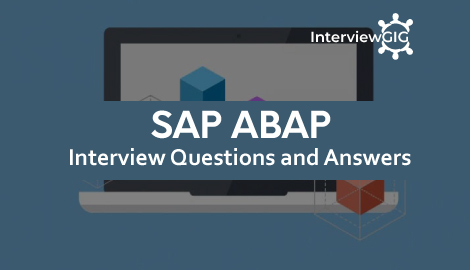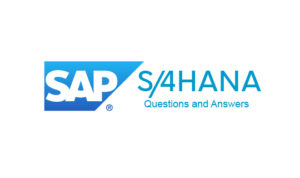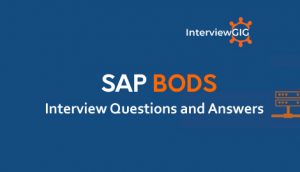SAP ABAP (Advanced Business Application Programming) is a fourth-generation programming language specifically designed for customizing and extending the functionalities of SAP software. It’s a procedural language with object-oriented features, enabling developers to create reports, data manipulations, interfaces, and complex business logic within the SAP environment. Proficiency in SAP ABAP is highly sought-after in various industries that heavily rely on SAP systems for core business operations.
Here, we have listed all the Top SAP ABAP Interview Questions and Answers for Fresher’s & Experienced.
What is SAP ABAP?
What is an ABAP?
What do you mean by an ABAP data dictionary?
What are domains and data element?
What is foreign key relationship?
What are the difference between pool tables and transparent tables?
What do you mean by Batch Data Communications programming?
What are the functional modules used in sequence in BDC?
What are the differences between table and structure in data dictionary?
Differentiate: Transparent tables, Cluster tables and Pooled tables
What is Smart Forms?
What are the components of SAP scripts?
How to create ‘table cluster’?
How can you format the data before write statement in the report?
Explain the difference between Template and Table?
Mention what is ALV programming in ABAP? When is this grid used in ABAP?
When do we use End-of-selection?
Mention the difference between ABAP and OOABAP? In what situation do you use OOABAP?
What is table buffer? Which type of tables used this buffer?
What is the use of ‘pretty printer’?
What is the difference between ‘Type’ and ‘Like’?
What are the different ABAP/4 editors? What are the differences?
What is the difference between dialog program and a report?
What is lock object?
How data is stored in cluster table?
How can you debug a script form?
What are different types of data dictionary objects?
What are the ways you can do the tuning? What are the major steps will you use for these?
In the ‘select’ statement what is ‘group by’?
What is dispatcher?
Mention what are the two methods of modifying SAP standard tables?
What is the difference between a ‘Database index’ and a ‘Match code’?
Explain the benefits of modularization technique?
How can you create callable modules of program code within one ABAP/4 program?
What are different types of parameters? How can you distinguish between different kinds of parameters?
What are the different databases Integrities?
What is the difference between macro and subroutine?
What are the advantages and disadvantages of using views in ABAP programming?
What type of user exits have you written?
Advanced SAP ABAP Interview Questions And Answers
Question: What is BADI (Business Add-In) and how is it different from User Exits?
Answer:
BADI:
- Object-oriented approach: Defined as a class interface with specific methods that can be implemented by different classes.
- Multi-level implementation: Can have multiple implementations for different purposes (e.g., partner, customer-specific).
- Upward compatibility guaranteed: Interfaces are future-proof, ensuring compatibility with future SAP releases.
- Multiple instances possible: Can have multiple active implementations at the same time.
User Exits:
- Procedural approach: Defined as specific points in SAP code where developers can insert their own code (function modules).
- Limited to single implementation: Only one implementation can be active at a time.
- Susceptible to compatibility issues: Modifications might need adjustments during SAP upgrades.
- Limited flexibility: Generally, have less control over the behavior compared to BADIs.
Question: What is the concept of ALV (ABAP List Viewer) and its types?
Answer:
ALV is a powerful tool for displaying data tables in SAP. It offers various functionalities and comes in two main types:
Grid Control: Provides a tabular view of data with sorting, filtering, and grouping capabilities.
Tree Control: Presents data hierarchically, similar to a file system structure.
Question: What is the difference between BDC and LSMW?
Answer:
BDC (Batch Data Communication):
- Older method: Uses recordings to automate data transfer between external systems and SAP.
- Less user-friendly: Requires technical expertise and can be complex to maintain.
LSMW (Legacy System Migration Workbench):
- Modern approach: Offers a user-friendly interface for defining data transfer processes.
- More flexible: Supports mapping, validation, and error handling features.
- LSMW is generally preferred today due to its ease of use and advanced capabilities.
Question: How does SAP Memory differ from ABAP Memory?
Answer:
SAP Memory: Refers to the shared memory space used by all instances of the SAP system on a server. It stores global data and buffers for optimal performance.
ABAP Memory: Represents the memory allocated to individual ABAP programs during execution. It holds local variables, temporary data, and program code.
Think of SAP Memory as the “shared apartment building” where all SAP instances reside, while ABAP Memory is each tenant’s “private apartment” within the building.
Question: What are the enhancements in SAP ABAP using Enhancement Framework?
Answer:
The Enhancement Framework provides a structured approach to customizing SAP functionality without directly modifying standard code. It utilizes techniques like:
- BADIs: Allow for flexible and reusable enhancements.
- Enhancement Points: Designated locations in standard code where custom logic can be inserted.
- Enhancement Spots: Areas in the user interface where custom elements can be added.
This framework helps maintain SAP system stability and avoid modification conflicts during upgrades.
Question: What is the purpose of SAP Smart Forms and SAPScripts?
Answer:
SAPScript: The older technology for creating printed reports in SAP. It offers limited formatting options and requires technical knowledge.
SAP Smart Forms: A more modern and user-friendly tool for designing reports. It provides rich formatting capabilities, easier development, and greater flexibility.
SAP Smart Forms is the preferred choice for report development in newer SAP systems.
Question: What is the use of SAP Web Dynpro for ABAP?
Answer: SAP Web Dynpro for ABAP is a framework for building dynamic user interfaces within SAP. It allows developers to create web-based applications that interact with SAP data and functionality, offering a more modern and user-friendly experience compared to traditional SAP screens.
Question: What is the difference between Classical Reports and Interactive Reports in SAP ABAP?
Answer:
Classical Reports: Traditional SAP reports that offer limited user interaction. They primarily display static data with basic formatting options.
Interactive Reports: Modern SAP reports that allow users to interact with the data through features like sorting, filtering, and drilling down into details. They provide a more dynamic and user-driven experience.
Interactive reports are becoming increasingly common due to their improved user experience and data exploration capabilities.
Question: How does SAP NetWeaver Gateway facilitate communication between SAP systems and external applications?
Answer: SAP NetWeaver Gateway acts as a mediator between SAP systems and external applications. It exposes SAP data and functionality as RESTful services, enabling seamless communication and integration with various technologies and platforms
Question: What is the role of SAP ALE in data communication between systems?
Answer: SAP Application Link Enabling (ALE) facilitates data exchange between different SAP systems. It utilizes standardized messages and protocols to ensure secure and reliable communication, enabling efficient data synchronization and business process integration.




